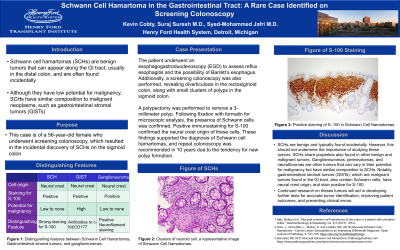Sunday Poster Session
Category: Colon
P0226 - Schwann Cell Hamartoma in the Gastrointestinal Tract: A Rare Case Identified on Screening Colonoscopy
Sunday, October 22, 2023
3:30 PM - 7:00 PM PT
Location: Exhibit Hall

Has Audio

Kevin Cobty, BS
Wayne State University School of Medicine
Detroit, MI
Presenting Author(s)
Kevin Cobty, BS1, Suraj Suresh, MD2, Syed-Mohammed Jafri, MD3
1Wayne State University School of Medicine, Detroit, MI; 2Henry Ford Hospital, Detroit, MI; 3Henry Ford Health System, Detroit, MI
Introduction: This is a unique case of a patient with Schwann Cell Hamartomas (SCHs) in the gastrointestinal tract found on screening colonoscopy.
Case Description/Methods: The patient is a 56-year-old female with a history of obesity, hyperlipidemia, and hypertension and her surgical history includes a laparoscopic sleeve gastrectomy performed ten years ago. She underwent an outpatient screening colonoscopy, which revealed diverticulosis in the recto-sigmoid colon as well as a 3 mm polyp in the sigmoid colon which was resected using jumbo cold forceps. The polyp was fixed with formalin for microscopic analysis. Histopathology demonstrated small clusters of Schwann cells in the lamina propria with no ganglion cells. There was no evidence of dysplasia. Immunostaining was also performed with S100 and a positive result confirmed the cells’ neural crest origin, supporting the diagnosis of Schwann Cell Hamartoma (SCH).
Discussion: SCHs are benign tumors that can form along the gastrointestinal tract but are most often found in the distal colon. They are typically found incidentally during an endoscopy. It is important to accurately identify these tumors to differentiate them from other tumors that are possibly malignant, such as gastrointestinal stromal tumors (GISTs). Although benign, SCHs are clinically significant because their composition can be similar to those of malignant tumors that share similarities in composition and location. SCHs are predominantly made of Schwann cells, which can be detected via immunohistochemical staining. Schwann cell hamartomas and other tumor cells that also originate from neural crest lineage will both react with the S100 marker. This can be used to differentiate SCHs from neurofibromas, perineuriomas, ganglioneuromas, or other tumors that are not entirely composed of Schwann cells. Because these other tumors can vary in their potential to grow, metastasize, or recur, it is important to be able to accurately distinguish them from SCHs to avoid unnecessary surveillance or treatment.
Disclosures:
Kevin Cobty, BS1, Suraj Suresh, MD2, Syed-Mohammed Jafri, MD3. P0226 - Schwann Cell Hamartoma in the Gastrointestinal Tract: A Rare Case Identified on Screening Colonoscopy, ACG 2023 Annual Scientific Meeting Abstracts. Vancouver, BC, Canada: American College of Gastroenterology.
1Wayne State University School of Medicine, Detroit, MI; 2Henry Ford Hospital, Detroit, MI; 3Henry Ford Health System, Detroit, MI
Introduction: This is a unique case of a patient with Schwann Cell Hamartomas (SCHs) in the gastrointestinal tract found on screening colonoscopy.
Case Description/Methods: The patient is a 56-year-old female with a history of obesity, hyperlipidemia, and hypertension and her surgical history includes a laparoscopic sleeve gastrectomy performed ten years ago. She underwent an outpatient screening colonoscopy, which revealed diverticulosis in the recto-sigmoid colon as well as a 3 mm polyp in the sigmoid colon which was resected using jumbo cold forceps. The polyp was fixed with formalin for microscopic analysis. Histopathology demonstrated small clusters of Schwann cells in the lamina propria with no ganglion cells. There was no evidence of dysplasia. Immunostaining was also performed with S100 and a positive result confirmed the cells’ neural crest origin, supporting the diagnosis of Schwann Cell Hamartoma (SCH).
Discussion: SCHs are benign tumors that can form along the gastrointestinal tract but are most often found in the distal colon. They are typically found incidentally during an endoscopy. It is important to accurately identify these tumors to differentiate them from other tumors that are possibly malignant, such as gastrointestinal stromal tumors (GISTs). Although benign, SCHs are clinically significant because their composition can be similar to those of malignant tumors that share similarities in composition and location. SCHs are predominantly made of Schwann cells, which can be detected via immunohistochemical staining. Schwann cell hamartomas and other tumor cells that also originate from neural crest lineage will both react with the S100 marker. This can be used to differentiate SCHs from neurofibromas, perineuriomas, ganglioneuromas, or other tumors that are not entirely composed of Schwann cells. Because these other tumors can vary in their potential to grow, metastasize, or recur, it is important to be able to accurately distinguish them from SCHs to avoid unnecessary surveillance or treatment.
Disclosures:
Kevin Cobty indicated no relevant financial relationships.
Suraj Suresh indicated no relevant financial relationships.
Syed-Mohammed Jafri: Gilead, Takeda, Abbvie – Advisor or Review Panel Member, Speakers Bureau.
Kevin Cobty, BS1, Suraj Suresh, MD2, Syed-Mohammed Jafri, MD3. P0226 - Schwann Cell Hamartoma in the Gastrointestinal Tract: A Rare Case Identified on Screening Colonoscopy, ACG 2023 Annual Scientific Meeting Abstracts. Vancouver, BC, Canada: American College of Gastroenterology.
